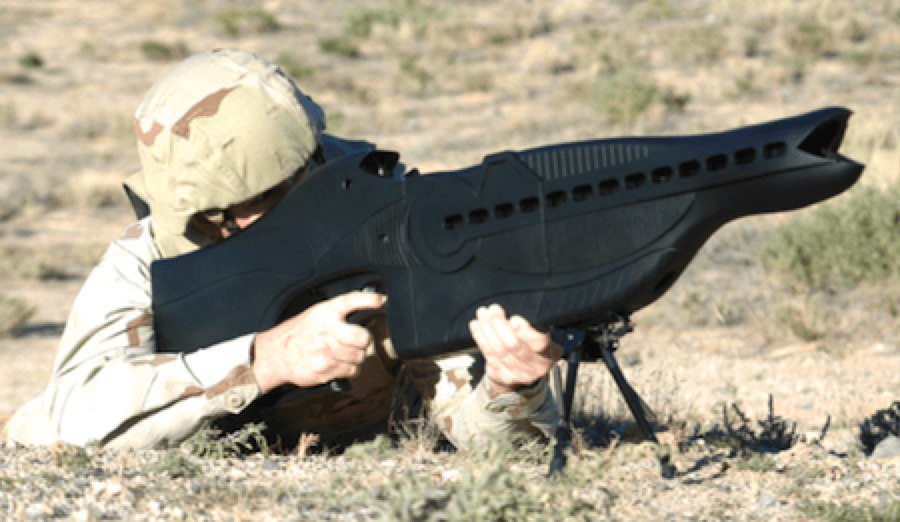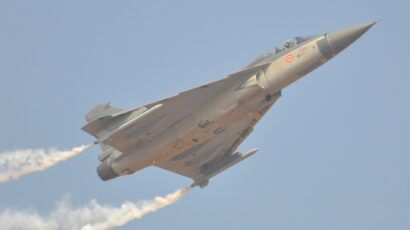Blinding them with science: Is development of a banned laser weapon continuing?
By Dan Drollette Jr | September 14, 2014

The subject gets little publicity nowadays, but until the mid-1990s, the US Air Force openly funded research on how to destroy human eyeballs at a distance with lasers. At the time, the justification was that such a technology—causing permanent blindness—was no worse than burning people with napalm, irradiating them, or blasting them to bits with bombs.
The research got quite far along; in 1995, Human Rights Watch identified at least 10 different laser blinding programs of concern, which the military ran under the names “laser countermeasure system,” BOSS, Persuader, LX-5, Saber 203, TLOS, Green Laser, Nighthawk, and Y-Blue, among others. In that same year a treaty, the New Protocol on Blinding Laser Weapons, was adopted by the United Nations; it banned such weaponry, and Bulletin contributing editor William Arkin penned a full-page story applauding the ban. He wrote: “The humanitarian considerations of this potentially horrific new chapter in warfare far outweighed the minor—and redundant—military benefit.”
But while the weapon itself was banned, research into laser weaponry was not, so work on it continued, under other rubrics. While I was an editor at a laser magazine in the early 2000s, my colleagues and I attended a year-round litany of multi-day conferences on the latest developments in lasers—and usually found Air Force researchers there, including those in the Department of Preventive Medicine and Biometrics at the Uniformed Services University of Health Sciences in Modesto, California. (Though located in California, their particular research was funded by the University of Illinois and the US Air Force.) In interviews in the year 2000, they said that technically speaking, they were researching with the aim of protecting America’s soldiers in the field from getting blinded by lasers, and doing so required them to study the precise laser settings that would cause the most damage to the human cornea. (For the record, researchers typically test their laser beams on artificial, eyeball-like tissue grown in petri dishes, which often consist of five layers of epithelial cells, each layer 0.450 nanometers thick.)
Researchers may have been careful to say that they were trying to protect US soldiers, but their logic could be interpreted as a fig leaf to get around the ban, which went into force in 1998. In interviews in 2000, Air Force-funded researchers admitted that it would be easy to turn their work to protect American soldiers around and use it to blind the enemy. It seems that at least part of the military rationale behind the technology is that a dead soldier is just dead, but a blinded one needs the help of others, thus tying up several enemy soldiers at once—similar to the thinking behind the use of landmines to blow off legs and arms.
Military-funded research in this area continues to be conducted by the Optical Radiation Bioeffects and Safety program—which sometimes contracts out the work to outside engineering firms. Research and development is also being conducted by firms such as B.E. Meyers Electro-Optics, makers of a laser device called the Glare Mout Plus, while the Joint Non-Lethal Weapons Directorate of the Defense Department leads the Pentagon’s end.
It is clear that lasers are being aimed at eyes in combat situations, but the militaries involved say the intent is not to blind, but to warn or protect against attack.
A 2010 article in the UK version of Wired says that laser “dazzlers” have been used by British soldiers against fighters in remote parts of Afghanistan—well away from public scrutiny. The Green Laser Optical Warner, or GLOW, is meant to temporarily stun, or “dazzle” the eye with glare. With an effective range of 300 meters, or nearly 1,000 feet, GLOW is intended to be used to stop suspicious characters from approaching a military checkpoint. It has been called an escalation of force option, providing an intermediate step before shooting starts. US forces used a similar device in Afghanistan and Iraq, the Green Laser Interdiction System, which has an effective range of a few kilometers at night, Laser Focus World wrote in 2012.
But something bright enough to dazzle at 300 meters can cause permanent eye damage at 50 meters, and these devices can be set to deliver a narrow (and more intense) beam. To get around the ban against blinding weapons, systems like the GLIS run off of a low-power source.
But the developers of the dazzler systems seem to be tiptoeing closer and closer to the line that defines what is a banned weapon and what is not—and their products are becoming more and more readily available. (One dazzler can be purchased for $15,999 on the Internet, although the seller notes that it is subject to government restrictions.)
Some laser dazzlers—supposedly intended for dazzling alone—are powerful enough to cause serious eye damage. Already, soldiers are taught not to fire when an intruder is too close, because of the laser’s power. One version, the Meyers’ 250 milliwatt LA9 dazzler, even has a built-in radar that shuts off the laser beam if it detects someone less than 41 meters away, or what is considered its nominal ocular hazard distance (NOHD), in which the beam is intense enough to cause eye damage. Other dazzlers like the Glare Enforcer are supposed to measure the distance to the target and switch to a low level that does not cause eye damage.
There is also a domestic version of the dazzler, meant for police use. The Dazer Laser, made by Laser Energetics, is supposed to flash rapidly at a low-intensity setting, theoretically causing nausea akin to motion sickness but no permanent injury. If this is true, the Dazer Laser could be a great advance in crowd control. The question is whether it could—either accidentally or after some modest intentional modification—cause lasting harm.
These dazzlers are not mere souped-up versions of laser pointers; sometimes, they are large, rifle-like weapons, although some versions are smaller and more lightweight, at under a pound.
So it seems that despite the UN’s 1995 Protocol on Blinding Laser Weapons, the world is moving closer to laser blinding weapons, and authorities are, by and large, turning a blind eye.
Together, we make the world safer.
The Bulletin elevates expert voices above the noise. But as an independent nonprofit organization, our operations depend on the support of readers like you. Help us continue to deliver quality journalism that holds leaders accountable. Your support of our work at any level is important. In return, we promise our coverage will be understandable, influential, vigilant, solution-oriented, and fair-minded. Together we can make a difference.
Topics: Analysis, Special Topics, Technology and Security















